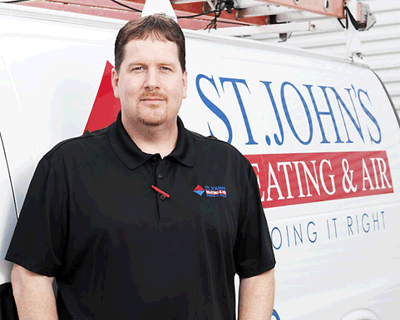
Heating, Ventilation, and Air Conditioning
Our service fee includes the technician’s travel to your home, a complete diagnostic of your unit, and a quote on any necessary repairs.
Check to be sure that the air conditioner or furnace is turned on. Check that the breakers and the disconnects are turned on and ensure the thermostat is set correctly. Also, make note of any strange noises or smells.
We take cash, checks, Visa, Mastercard, Discover, as well as multiple financing options.
Today’s heating and A/C equipment are so complex and diverse it is next to impossible to give simple answers to this question. Having a qualified technician diagnose a problem is the best way to keep yourself informed.
All of our technicians are certified through EPA and NATE.

Maintenance visits are provided to customers that are a part of our Planned Maintenance Program. These are much more in-depth than a tune-up. Our PMP provides cleaning, routine maintenance, extra warranties, discounts, and priority service. A tune-up can only be purchased during certain times of the year. They are the basic checking of your unit to ensure that all moving parts are working as they should be and that all levels and readings are according to factory specifications.
You wouldn’t buy a brand-new car and expect to never have to put air in the tires, change the oil and check out any unusual noises, would you? In the same way that an automobile requires periodic maintenance for optimal performance, a qualified technician should regularly inspect a home comfort system.
Yes! Even though the components of your HVAC system are new, they still need to have annual maintenance performed. This will keep them performing better and help keep the warranties in effect. In their warranty, almost all equipment manufacturers state that a qualified technician must perform annual maintenance. Keeping your system maintained will give you the assurance that it is operating at peak efficiency and safety.
Regular filter changes help your heating and air system operate at peak efficiency and improve the air quality in your home. Therefore, it is essential to change filters regularly. Depending on the type of filter your system requires, it may need to be changed monthly or bi-annually. If you are not sure, one of our Technician Specialists can answer that for you!
The inside of your system can become very dirty. In addition to harboring dust that makes its way beyond the air filter, the coils and components inside can become very moist. The grimy layer that develops can be tough to remove, requiring special cleaning solutions and tools. Although some homeowners attempt to scrub the parts on their own, it’s possible to damage the coils’ fins and affect the system’s performance. Some homeowners use household cleaning products, not thinking that the related fumes may be introduced into the air stream.
Your drain pan and lines should also be professionally cleaned to ensure that condensate liquids can easily move out of the house. Your outdoor equipment should be inspected and cleaned by a certified technician who can evaluate the condition of electronic parts.

A Technician Specialist comes to your home to diagnose a problem you are having and give you the solutions and repairs that can fix the problem. Their area of training and expertise is strictly in this area. However, a Comfort Specialist is specifically trained in installing new units. They will know precisely how to calculate the proper size unit that you need for your home.
Contrary to popular belief, there is no rule of thumb for sizing a system to a home. Depending upon the construction of your home, one ton of air conditioning can cool anywhere from 300 to 800 square feet of home. Therefore, the only way to ensure the size of the system you purchase will be large enough to cool your home, but not any larger than you need, is to have your home’s cooling and heating needs evaluated by a licensed professional.
A skilled HVAC Comfort Specialist doesn’t only use the square footage to make a load calculation. Each home or business has individual features that can affect the building’s heating and cooling needs. The structure’s overall design, construction, level of insulation, and orientation to the sun must all be considered.
SEER (Seasonal Energy Efficiency Ratio): This ratio tells you how much cooling your system will deliver per dollar spent on electricity. The SEER rating of any unit can range anywhere from 13 to 25. The higher the SEER, the more efficient the system will be and the less it will cost in the long run to own and operate.
AFUE (Annual Fuel Utilization Efficiency ratio): A measurement of the percent of heat produced by a furnace for every dollar of fuel consumed. The higher the AFUE rating, the lower the fuel costs. All furnaces manufactured today must meet at least 78%. Older furnaces (10-15 years or older) may fall below this minimum. Furnaces with AFUE ratings from 78% to 80% are considered mid-efficiency; those with above 90% are considered high efficiency.
Most systems have a lifetime of 10 to 15 years. As your equipment gets older, its efficiency can decrease dramatically. You may notice that it gets noisier and needs repairs more often. When a unit begins to show its age, you have two choices – You can overhaul the system or replace it. Because heating and cooling technologies improve over time, a new system designed with newer, more energy-efficient equipment makes sense, especially if your system is seven or more years old. Our Comfort Specialists can provide a FREE in-home estimate of the cost of a new system as well as a payback schedule that will show you how much a newer, more efficient system will pay you back in lower utility bills.
Each brand is unique and caters to different heating and air preferences. Depending on your home and individual situation, we will assess what HVAC brand would be best suited for your needs.
Suppose you have a qualified technician perform regular preventive maintenance and service suggested for your unit. In that case, industry averages suggest that an air conditioner should last 10-15 years and a gas furnace should last up to 20 years.

